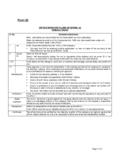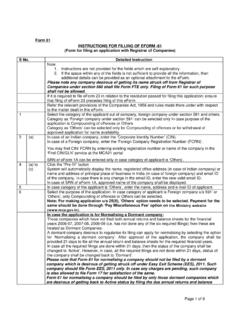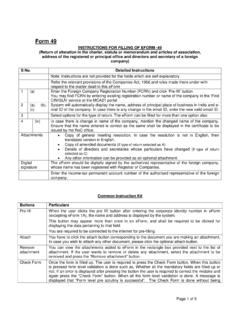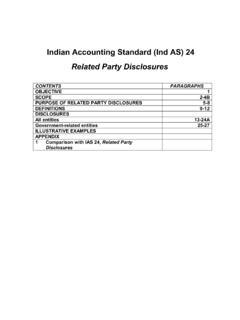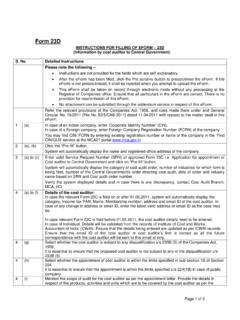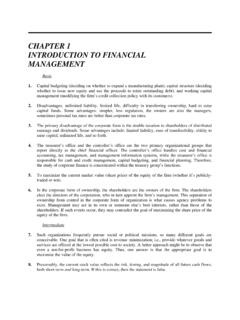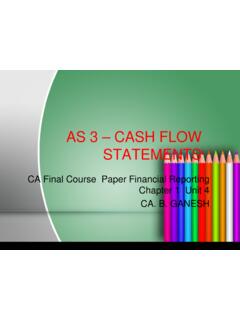Transcription of Cash Flow Statements Contents
1 16 Accounting Standard (AS) 3 cash flow StatementsContents OBJECTIVE SCOPE Paragraphs 1-2 BENEFITS OF cash flow INFORMATION 3-4 DEFINITIONS 5-7 Cash and Cash Equivalents 6-7 PRESENTATION OF A cash flow STATEMENT 8-17 Operating Activities 11-14 Investing Activities 15-16 Financing Activities 17
2 REPORTING CASH flows FROM OPERATING ACTIVITIES 18-20 REPORTING CASH flows FROM INVESTING AND FINANCING ACTIVITIES 2 1 REPORTING CASH flows ON A NET BASIS 22-24 FOREIGN CURRENCY CASH flows 25-27 EXTRAORDINARY ITEMS 28-29 INTEREST AND DIVIDENDS 30-33 TAX ES ON INCOME 3 4 - 3 5 Continued ../ .. 17 INVESTMENTS IN SUBSIDIARIES, ASSOCIATES ANDJOINT VENTURES 3 6 ACQUISITIONS AND DISPOSALS OF SUBSIDIARIES AND OTHER BUSINESS UNITS 37-39 NON-CASH TRANSACTIONS 40-41 COMPONENTS OF CASH AND CASH EQUIVALENTS 42-44 OTHER DISCLOSURES 45-48 ILLUSTRATIONS cash flow Statements 53 Accounting Standard (AS) 3 cash flow Statements (This Accounting Standard includesparagraphsset inbolditalic type and plain type, which have equal authority.)
3 Paragraphs in bold italic type indicate the main principles. This Accounting Standard should beread in the context of its objective and the General Instructionscontained in part A of the Annexure to the Notification.) This Accounting Standardis not mandatoryforSmall andMedium SizedCompanies, as defined in the Notification. Such companies are howeverencouraged to comply with the Information about the cash flows of an enterprise is useful in providing users of financial Statements with a basis to assess the ability of the enterprise to generate cash and cash equivalents and the needs of the enterprise toutilise those cash flows .
4 The economic decisions that are taken by usersrequire an evaluation of the ability of an enterprise to generate cash andcash equivalents and the timing and certainty of their generation. The Standard deals with the provision of information about the historicalchanges in cash and cash equivalents of an enterprise by means of a cashflow statement which classifies cash flows during the period from operating,investing and financing activities. Scope 1. An enterprise should prepare a cash flow statement and should present it for each period for which financial Statements are Users of an enterprise s financial Statements areinterestedin how theenterprise generates and uses cash and cash equivalents.
5 This is the caseregardless of the nature of the enterprise s activities and irrespective ofwhether cash can be viewed as the product of the enterprise, as may be thecase with a financial enterprise. Enterprises need cash for essentially thesame reasons, however different their principal revenue-producing activitiesmight be. They need cash to conduct their operations, to pay their obligations,and to provide returns to their investors. cash flow Statements 19 Benefits of cash flow Information 3. A cash flow statement, when used in conjunction with the other financial Statements , provides information that enables users to evaluate the changesin net assets of an enterprise, its financial structure (including its liquidity andsolvency) and its ability to affect the amounts and timing of cash flows inorder to adapt to changing circumstances and opportunities.
6 Cash flowinformation is useful in assessing the ability of the enterprise to generatecash and cash equivalents and enables users to develop models to assess and compare the present value of the future cash flows of differententerprises. It also enhances the comparability of the reporting of operatingperformance by different enterprises because it eliminates the effects ofusing different accounting treatments for the same transactions and Historical cash flow information is often usedas an indicator of theamount, timing and certainty of future cash flows . It is also useful in checkingthe accuracy of past assessments of future cash flows and in examining therelationship between profitability and net cash flow and the impact ofchanging prices.
7 Definitions 5. The following terms are used in this Standard with the meanings specified: Cash comprises cash on hand and demand deposits with Cash equivalentsare short term, highly liquid investments thatare readily convertible into known amounts of cash and which aresubject to an insignificantrisk Cash flows are inflows and outflows ofcash and cash equivalents. Operating activities are the principal revenue-producing activities of the enterprise and other activities that are not investing orfinancing activities. Investing activities are the acquisition and disposal of long-term assets and other investments not included in cash equivalents.
8 Financing activitiesare activities thatresultinchangesinthe sizeand composition of the owners capital (including preference sharecapital in the case of a company) and borrowings of the enterprise. 20 AS3 Cash and Cash Equivalents 6. Cash equivalents are held for the purpose of meeting short-term cashcommitments rather than for investment or other purposes. For an investment to qualify as a cash equivalent, it must be readily convertible to a knownamount of cash and be subject to an insignificant risk of changes in , an investment normally qualifies as a cash equivalent only whenit has a short maturity of, say, three months or less from the date of in shares are excluded from cash equivalents unless they are, insubstance, cash equivalents; for example, preference shares of a companyacquired shortly before their specified redemption date (provided there isonly an insignificant risk of failure of the company to repay the amount atmaturity).
9 7. Cash flows exclude movementsbetween items that constitute cash orcash equivalents because these components are part of the cash management of an enterprise rather than part of its operating, investing and financingactivities. cash management includes the investment of excess cash in cashequivalents. Presentation of a cash flow Statement 8. The cash flow statement should report cash flows during the periodclassified by operating, investing and financing An enterprise presents its cash flows from operating, investing and financing activities in a manner which is most appropriate to its by activity provides information that allows users to assess theimpact of those activities on the financial position of the enterprise and theamount of its cash and cash equivalents.
10 This information may also be usedto evaluate the relationships among those activities. 10. A single transaction may include cash flows that are classified differently. For example, when the instalment paid in respect of a fixed assetacquired on deferred payment basis includes both interest and loan, the interestelement is classified under financing activities and the loan element isclassified under investing activities. Operating Activities 11. The amount of cash flows arising from operating activities is a keyindicator of the extent to which the operations of the enterprise have generatedsufficient cash flows to maintain the operatingcapabilityof the enterprise, cash flow Statements 21 pay dividends, repay loans andmake new investments without recourse toexternal sources of financing.
